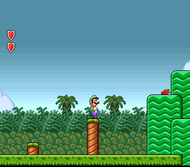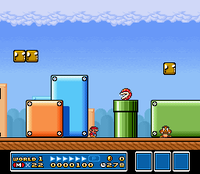Super Mario All-Stars
|
|
| Super Mario All-Stars | |
| Missing image Super_Mario_All-stars_box.jpg Super Mario All-Stars cover art | |
| Developer(s) | Nintendo |
| Publisher(s) | Nintendo |
| Release date(s) | July 14, 1993 (JP) August 1, 1993 (NA) December 16, 1993 (EU) |
| Genre | Platform |
| Mode(s) | Single player, multiplayer |
| Rating(s) | ESRB: Kids to Adults (K-A) |
| Platform(s) | SNES |
Super Mario All-Stars, known in Japan as Super Mario Collection (スーパーマリオコレクション), is a video game that was developed and published by Nintendo for the Super Nintendo Entertainment System in 1993. It contains enhanced remakes of Super Mario Bros., Super Mario Bros. 2 (Japanese: Super Mario USA), Super Mario Bros. 3, and Super Mario Bros.: The Lost Levels (Japanese: Super Mario 2).
- Note that there is an alternate version of this game that came bundled with Super Mario World as well as the rest of these games.
Super Mario All-Stars was one of the first enhanced remakes. The graphics were recolored and enhanced for the Super Famicom/SNES, and many bugs from the original versions were fixed. Gameplay has also been streamlined. The sounds and background music were enhanced from their original representations. A save feature was added to all of the games. Super Mario Bros. 2 was given the most enhancements. The Bowser encounter themes in Super Mario Bros. and Super Mario Bros.: The Lost Levels are unique to Super Mario All-Stars. Super Mario Bros: The Lost Levels is the Super Famicom/Super NES version of the Japanese Super Mario Bros. 2, which was originally released for the Nintendo Family Computer in Japan in 1986.
| Contents |
Super Mario Bros. and Super Mario Bros.: The Lost Levels
Missing image SuperMarioBrosSNESTitle.png SMB: Super Mario All-Stars/Collection version |
Missing image Supermariobroslltitle.PNG SMBLL: Super Mario All-Stars/Collection version | Missing image Supermariobros2FAMICOMtitle.gif SMBLL: Famicom standalone version |
In the Famicom/NES version of Super Mario Bros. and Super Mario Bros.: The Lost Levels (Japanese: Super Mario Bros. 2), there was not a 50 points per timer tick bonus at the end of a World x-4 level, but the Super Famicom/SNES version contains the feature. Players no longer need to hold A while pressing Start to continue, because they can now continue from a saved game. Bowser, Princess Toadstool, and the mushroom retainers have been given new animations, and new background music plays during encounters with Bowser. Maze levels such as World 4-4 and 7-4 in Super Mario Bros., have sound effects that indicate the correct path for Mario or Luigi to take. Collisions with the pipe-plants include the top eight pixels (in the original, all enemies except Bowser collided as 16x16, even if they looked larger). The Minus world trick for Super Mario Bros. was removed from the game when it made its transition to All-Stars, as was Little Fiery Mario.
Super Mario Bros. 2/Super Mario USA
Super Mario Bros. 2, or Super Mario USA (as it is known in Japan), was given the most enhancement. Level introductions now feature a colorized and animated level representation. The slot machine bonus game has been enhanced, including enlarged slots and icons, and a new "7" icon. In the Famicom/NES version, the player can only get up to five extra lives; however, in the Super Famicom/SNES version, with the addition of the "7" icon, the player can now get up to ten extra lives. As for continuing after losing the last life, on the Famicom/NES version, the player can only continue twice per game. However, on the Super Famicom/SNES version, the player can continue the game any number of times, because he or she can continue from a saved game. In the Famicom/NES version, the player can select a character at the beginning of each level, but must play as the character for the length of the level. In the Super Famicom/SNES version, the player can select a character at the beginning of each level and may change the character upon losing a life. Super Mario Advance is based on the Super Famicom/SNES version of Super Mario Bros. 2.
Super Mario Bros. 3
Missing image Super_Mario_Bros_3_Classic.jpg SMB3: NES/Famicom standalone version |
While Super Mario Bros. 3; had significant graphical enhancements, the game wasn't given upgrades to the extent that Super Mario Bros. 2 had. The action scene, spade panels, and other world map elements have been animated, replacing the kings' original animal forms with monsters from various other Mario games; for instance, the king transformation graphics have been changed for Super Mario All-Stars. The king in World 7 of Super Mario Bros. 3 was transformed into a Yoshi in the Super Famicom/SNES version, but was transformed into a Piranha Plant in the Famicom/NES version. Also, the Super Famicom/SNES version grants the player the ability to save the game. The Super Famicom/SNES version is closer to the Japanese Famicom version than to the American NES version, but is still a combination of the two. The "suit flying off" animation that was on the Japanese Famicom version was dummied out of the American NES version, but it returned on the Super Famicom/SNES version. Super Mario Advance 4: Super Mario Bros. 3 contains the Super Famicom/SNES version of Super Mario Bros. 3.
Super Mario World
Super Mario World is only included in the Super Mario All Stars/Super Mario World pack that was bundled with the SNES in December 1994. The only graphical difference is that the game contains unique sprites for Luigi (the second player), making him taller and slimmer than Mario, whereas the original version of the game used palette swapped Mario sprites for him. In addition, there are some different animations for Mario and Luigi's moves. Some of the differences are that Luigi scrunches up when spitting a fireball and that Luigi slides down hills on his knees.fr:Super Mario All-Stars ja:スーパーマリオコレクション no:Super Mario All-Stars




